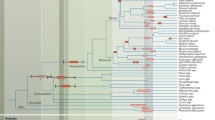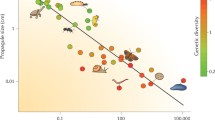Abstract
The potentialities of diploid and tetraploid organisms for conserving variation which is genetical information are compared. While tetraploidy enhances the conservation of variation, it does not in general appear to do so by a factor of two, which might have been expected from the difference in the amount of genetic material.
Similar content being viewed by others
References
Astaurov B. L. (1969). Experimental polyploldy in animals. Ann. Rev. Genet. 3: 99–126.
Beçak W. (1969). Genic action and polymorphism in polyplold species of amphibians. Genetics 61 (Suppl.) 1: 183–190.
Clarke B. C. (1970). The Darwinian evolution of proteins. Science 168: 1009.
Ewens W. J. (1969). A generalised fundamental theorem of natural selection. Geneties 63: 531.
Ewens W. J. & G. Thomson (1970). Heterozygote selective advantage. Ann. Hum. Genet. 33: 365–376.
Fisher, R. A. (1930). The genetical theory of natural selection. (2nd ed.), New York.
Fisher, R. A. (1953). Statistical information. In: H. Quastler (Ed.), Information Theory. Urbana.
Fisher, R. A. (1958). The genetical theory of natural selection. (2nd ed.), New York.
Fisher R. A. & K. Mather (1943). The inheritance of style length in Lythrum salicaria. Ann. Eugen. 12: 1–23.
Haldane J. B. S. (1926). A mathematical theory of natural and artificial selection. III. Proc. Camb. Phil. Soc. 23: 363–372.
Hecht A. (1944). Induced tetraploids of a self sterile Oenothera. Genetics 29: 69–74.
Hecht A. (1949). Tetraploid ratios of self sterility alleles: a correction. Geneties 34: 685–686.
Kimura M. (1968). Evolutionary rate at the molecular level. Nature 217: 624–626.
Lewis D. (1947). Competition and dominance of incompatibility alleles in diploid pollen. Heredity 1: 85–108.
Mayo O. (1966). On the problem of self-incompatibility alleles. Biometrics 22: 11–120.
Mayo O. (1970). Fixation of new mutants. Nature 227: 660.
Mayo O. & D. L. Hayman (1968). The maintenance of two loci systems of gametophytically determined self incompatibility. Proc. XII Intern. Congr. Genet. 1: 331.
Mayo, O. & D. L. Hayman (1971). On the stability of systems of gametophytically determined self incompatibility (In preparation).
Robertson A. (1962). Selection for heterozygotes in small populations. Geneties. 47: 1291–1300.
Sheppard P. M. (1958). Natural Selection and Heredity. Hutchinson, London.
Waddington, C. H. & R. C. Lewontin (1967). A note on evolution and changes in the quantity of genetic information. In: C. H. Waddington (Ed.) Towards a theoretical biology Vol. 1. Edinburgh.
Wright S. (1935). The analysis of variance and the correlations between relatives with respect to deviations from an optimum. J. Genet. 30: 243–256.
Wright S. (1938). The distribution of gene frequencies in populations of polyploids. Proc. Nat. Acad. Sci. U.S.A. 24: 372–377.
Wright S. (1939). The distribution of self incompatibility alleles in populations. Genetics 24: 538–552.
Author information
Authors and Affiliations
Rights and permissions
About this article
Cite this article
Mayo, O. Rates of change in gene frequency in tetrasomic organisms. Genetica 42, 329–337 (1971). https://doi.org/10.1007/BF00123327
Received:
Issue Date:
DOI: https://doi.org/10.1007/BF00123327




